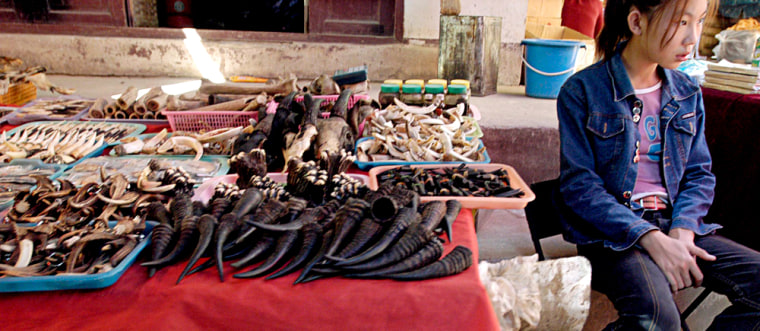Furry bear paws lie next to neatly arranged skins of jungle cats, skulls of monkeys and horns of mountain goats. The parts of vanishing species from Southeast Asia’s forests are laid out for Chinese buyers seeking sex boosters, cures for cancer and exotic food.
“Very strong. It can fight with a tiger, so it’s good for sex,” the vendor says, pointing to a pair of wild buffalo horns priced at $125 and explaining that in powder form they’ll surely enhance virility given the animal’s power.
A sizable quantity of wildlife is felled to supply dealers in this scruffy town on the Thailand-Myanmar border. But Tachileik is just one node of a trade network that funnels fauna and flora from across the region to satisfy a seemingly insatiable demand in China.
There, millions of people still believe that rhino horn prevents convulsions, pickled turtle flippers increase longevity and fresh snake blood makes for a potent aphrodisiac. And with China’s growing affluence, more can afford exotic wildlife dishes once served only at banquets of the elite.
China 'vacuuming it up'
Having strained China’s domestic supply, the network’s tentacles are extending to scoop up pangolins in Indonesia, snakes from Vietnam, dendrobium orchids in Laos and the few remaining tigers and bears in Myanmar.

“The biggest problem facing wildlife in Southeast Asia is its domestic consumption in China. The Chinese are vacuuming it up,” says Steven Galster, who heads the conservation group WildAid Asia.
Despite some efforts by the Chinese government to curb the trade, ecologists agree the current harvest is unsustainable and will inevitably lead to the eradication of species.
“It doesn’t look good. We are at the stage where a lot of species are on the edge. There haven’t been a lot of extinctions, but there will be soon,” says James Compton, who heads the Southeast Asian office of Traffic, an international treaty agency that monitors trade in wildlife.
Since much of the trade is illegal and often conducted in remote areas, it’s difficult to pinpoint numbers. But Compton and others offer some indications of its scale and range:
- Turtles: Researchers have a far better chance of finding rare turtles in the markets of Shanghai or Guangzhou than the wilds of Southeast Asia, where more than half the species are listed as endangered. As much as 10,000 tons of freshwater turtles are annually traded in the region for use in food and traditional medicine, creating what the experts say is an “Asian turtle crisis.” In Laos, villagers who a decade ago could sell a golden turtle, the blood of which is said to cure cancer, for $100 now get $1,000. “If a Chinese industrialist has a tumor, he’ll offer anything,” says Roland Eve, who directs the World Wide Fund for Nature in Laos.
- Seahorses: The tiny seahorse is classified as vulnerable worldwide chiefly because in dried form it is used in Chinese traditional medicine to treat asthma, heart disease, impotence and other ills. Project Seahorse, a conservation group, estimates 20 million of the creatures are taken each year in the South China Sea and elsewhere, with 95 percent ending up in Chinese apothecaries.
- Pangolins: Having decimated the pangolin populations in Laos, Thailand, Myanmar and China itself, smugglers now seek the scaly anteater in Malaysia and Indonesia. In the first eight months of 2003, some 10,000 animals smuggled from the Indonesian archipelago were seized in southern Thailand. Selling for $45 a pound in Shanghai, pangolin meat is regarded as highly nutritious while its scales are prescribed for ailments ranging from skin diseases to lack of milk in breast-feeding mothers.
Shift in species sought
The region’s pangolins, snakes and freshwater turtles are now the most intensely sought-after species, having eclipsed the trade in tiger bone, rhino horn and bear gall bladder due to decimation of the latter species and tougher policing of the smuggling of those parts.
The harvesters of wildlife in Southeast Asia are generally poor villagers and fishermen who sell to local markets or small-time dealers, who pass the products into the well-established, sophisticated trade networks crisscrossing the region.
The big-time operators, WildAid and Traffic say, often employ the same routes used for smuggling drugs, people and even weapons, seeking passages where corruption is rife and law enforcement lax. Authorities have nabbed shipments of drugs stuffed into dead animals and of frozen shrimp with iced pangolin or snakes layered beneath them.
The routes are sometimes long and circuitous. A wildlife shipment from Sumatra in Indonesia may pass through Malaysian-Chinese middlemen in Kuala Lumpur who bribe airport officials and fly the cargo by private plane to Vientiane, Laos. It can then be trucked to Vietnam and finally to China through thriving Vietnamese-Chinese wildlife ventures. Singapore and Thailand are also important transit countries.
En route, documents are forged or altered to comply with the U.N. Convention on International Trade in Endangered Species, which most countries in the region, including China, have signed.
Some documents falsely list the source of flora and fauna to farms to get around trade in species proscribed under CITES although these may actually have originated in the wild or been “laundered” through enterprises that breed musk deer, bears, tigers and other endangered species. On farms in China, thousands of live bears are “milked” for their bile, said to fight liver disease, through steel catheters implanted in their gall bladders.
'Big shipments go free'
Although enforcement efforts have been stepped up in recent years, Compton says far more manpower and funds are needed, especially in the wake of trade liberalization in the region and the proliferation of air and road links with China.
“Everyone has been biting around the edges, catching the poor villager or trader, the little guys, while the big shipments go free. It’s just like the early days of the war on drugs,” Galster says.
But as in the drug war, conservationists say, strikes against suppliers must be complemented by education to lessen demand.
“When the buying stops, the killing can, too,” is the theme of a widely shown WildAid television spot featuring Asian and international celebrities like kung fu actor Jackie Chan. Peter Benchley, author of the best-selling novel “Jaws,” urges people to shun shark’s fin soup.
In China, the world’s No. 1 consumer of wildlife, the government has begun trying to curb the trade. It pledged in 1999 to secure sustainable trade in wild plants and animals and has banned use of internationally protected species.
Last year, in face of SARS, believed to have sprung from civet cats in southern China’s wildlife markets, officials clamped curbs on the eating of wildlife and launched the “Spring Thunderstorm” campaign to go after illegal traders. Early in 2004, authorities made the largest wildlife haul in modern Chinese history, seizing the skins of 31 Bengal tigers, 581 Asian leopards and 778 otters worth more than $1.2 million.
“I think the Chinese government is trying to do something about it, but it is not easy. This is such a part of traditional culture,” says Qin Liyi, an officer with the World Conservation Union office in Beijing.
Breaking health habits
It is also a multibillion-dollar industry, built on consumer beliefs arising from 3,000 years of adherence to traditional Chinese medicine.

The complex, comprehensive approach to health includes the use of more than 11,000 plants and 1,500 animals, and some of its tenets, such as a holistic approach to well-being, have garnered praise worldwide.
But many of the animal parts used for medicines or tonics have been shown scientifically to have no efficacy. This however, Qin notes, doesn’t convince people, especially among the older generation, whose faith in the ancient remedies approaches religious fervor.
The Chinese, especially those in the country’s southern regions like the Cantonese, are yet to be weaned from “ye wei” — “wild taste” — the belief that exotic fare endows them with added social status and the traits of the animal consumed, such as bravery, long life or sexual prowess.
Conservationists are updating an age-old adage about such omnivorous eating habits: “The Cantonese will eat anything with legs except a table and anything with wings except an airplane.”
